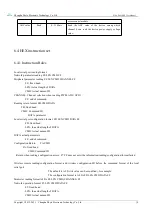
Chengdu Ebyte Electronic Technology Co.,Ltd.
E180-Z8910SP User Manual
Copyright ©2012–2021
,
Chengdu Ebyte Electronic Technology Co.,Ltd.
6
Serial port configuration: The module has built-in serial port commands, and users can configure (view) the
parameters and functions of the module through the serial port commands.
Change of network PAN_ID: Any switch of network PAN_ID, users can customize PAN_ID to join the
corresponding network or automatically select PAN_ID to join the network;
GPIO control: local/remote GPIO level control, 3 IOs can be selected;
PWM control: local/remote PWM control, 4 PWM channels for users to choose;
ADC control: local/remote ADC reading, 3 ADC channels for users to choose (including power supply voltage
detection);
One key to restore the baud rate: If the user forgets or does not know the baud rate, this function can be used to
restore the default baud rate to 115200.
Serial port receive wakeup: support the serial port receive wakeup function. When the module is in sleep state, it
will be awakened when a frame of data is received. This data is a wake-up frame used to wake up the module and
will not be processed as data.
Module reset: the user can reset the module through the serial port command.
Restore factory settings: the user can restore the factory settings of the module through the serial port command
Over-the-air configuration: the user can use the over-the-air configuration command to remotely configure other
devices in the network
1.3 Introduction of Equipment Type
There are four types of logical devices in the ZigBee network: Coordinator, Router, End-Device and Sleep-End-Device.
The ZigBee network consists of a Coordinator, multiple Routers, and multiple End_Devices (the terminal nodes can be
divided into sleeping terminals and non-sleeping terminals). This product supports all nodes and can be interconnected
with E180-ZG120A/B, E180-Z6907, E180-Z5812 and other models.
1.3.1 Non-sleeping terminal
The main task of the terminal device is to send and receive messages, and other nodes are not allowed to connect with the
terminal device. A non-sleeping terminal is always in the working state and can receive and send data at any time.
1.3.2 Sleeping terminal
The dormant terminal, when there is no data transmission and reception, enters the dormant state, the dormant current is
as low as about 1.1uA, and the pins that are not used by the dormant terminal node should be left floating. After sleep, all
pins of the module have been configured as pull-down input mode, but the GPIO1 and GPIO2 channels do not support
pull-down input. If the two GPIO channels of the sleep node are connected to an external circuit, it will affect the sleep
power consumption of the module.
When you need to send wireless data or perform command operations, you need to send a wake-up frame through the
serial port first. It is recommended to use "FF FF FF FF FF" with 5 bytes of "FF" to wake up. The wake-up time lasts for
Uart_holdtime, during which serial data can be processed. (Configuration command, effective load), when a frame of
serial port data is successfully received, the wake-up timeout counter will be refreshed, and the wake-up duration will go
further by Uart_holdtime, otherwise the device will go to sleep again. Uart_holdtime defaults to 1000ms and supports
HEX command to change its value.
Sleep terminal wake-up can also be awakened through the function pin WAKE. WAKE defaults to high level. Pull down
the WAKE pin to wake up the module continuously, and release the WAKE pin to restore the default high-level module







































